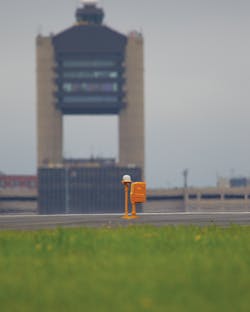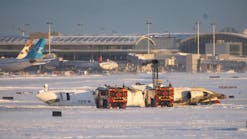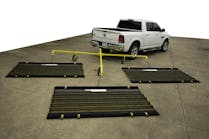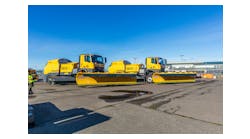At airports, there are three letters that spell big problems: FOD.
Short for foreign object debris left behind on airport runways, taxiways and aprons, the fragments pose a significant problem that leads to damages in the billions of dollars for airports and airlines every year.
Left untouched or unnoticed, these three letters can represent another word too—Disaster.
On July 25, 2000, a metal strip detached from a Continental Airlines plane and fell on the runway at Paris Charles de Gaulle Airport. This debris punctured the tire of a departing Air France Concord jet spewing bits of rubber into the air, some of which punctured the aircraft’s fuel tanks causing the plane to crash shortly after take-off, killing 113 people.
In the years since, Charles de Gaulle installed an automated FOD detection system from Xsight Systems, headquartered in Boston, Mass., to supplement the manual checks already being performed. Airports in Tel Aviv and Bangkok have also followed suit, according to Arik Fux, head of Xsight’s U.S. office.
And in November, Boston Logan International Airport unveiled a $1.7 million FODetect system on 09-27, the airport’s busiest, 7,000-foot-long runway. This installation is the first of its kind in the United States. “We are honored to be selected for this installation, 13 years after the Concord crash,” says Fux. “Massport (the Massachusetts Port Authority) is very proactive in adding cutting-edge technology that helps keep the airport as safe as possible.”
The FAA funded $900,000 of the project through the Airport Technology Research Program, under an agreement that enabled Massport to provide the remaining funding and procure the Xsight technology. The agreement also calls for a one-year-study to evaluate the safety benefits of the automated detection system versus traditional FOD best practices, reports the FAA.
“Using technology to find and remove potentially damaging objects on the airfield takes safety up another notch at Boston Logan,” said Christa Fornarotta, FAA associate administrator for airports, when the project was unveiled. “Massport has a long history of investing in cutting-edge technology and working with the FAA on important airport safety initiatives.”
The Case for Automation
Currently, the FAA requires airports to manually check their runways, taxiways and aprons at least once every 24 hours. But this is a regulation set decades ago when air traffic volumes were far smaller than they are today, according to Fux.
Airports traditionally use vehicles to scan pavement and rely on sweepers, vacuums and magnetic bars to clear the debris. Massport currently performs such checks three times a day, and will continue to do so even with the automated technology in place.
A manual inspection system works remarkably well, but it is subject to human error. “An automated runway inspection by machine can do a better job than a human,” Fux says. “There may be hundreds of takeoffs and landings in between every manual inspection. An automated system scans continuously.”
Boston Logan’s automated FODetect system features 68 sensors, mounted on runway light fixtures every 200 feet, which continuously scan 180 degrees along the length of the runway, looking for debris that might include things like dislodged airplane parts, chunks of asphalt, metal shards, bolts, rocks and more. The system utilizes an integrated optic sensor with NIR illumination and millimeter-wave radar sensing technology to detect the smallest FOD and birds. The technology is supported by the company’s proprietary image processing software, and the system’s Surface Detection Units include a powerful local processing unit connected to the system server and operator interface, making it possible to scan runway surfaces in under a minute.
When the system spots an object—even one as small as a rivet, it activates an audio-visual alarm in the airport’s control tower and sends live video feeds and GPS coordinates for the object to appropriate airport personnel, who evaluate whether the debris must be removed. An operator views the live video of the detected object and receives physical data (size and location) to help him determine whether to take action in compliance with FAA AC 150/5210-24 Chapter 6.
“The system’s FOD visualization and interrogation capabilities assist the operator in identifying the FOD, its location and its size to minimize false alarms,” Fux says. “And if the FOD is determined a danger, operators can then use its GPS location, blinking closest edge light, and its number and laser line marker to pinpoint the FOD and quickly retrieve it.”
FODetect is remarkably accurate, according to Fux. “The distance from the sensor to the area being scanned is up to 100 feet,” he says. “It’s a very close distance, allowing the operator to zoom in to obtain a clear image of what’s going on.” He explains that if the sensors were located further away, both inclimate weather conditions and objects would stand between the sensor and the pavement being scanned.
“Because we’re co-located with the runway edge lights, there is nothing between the sensors and the runway,” he says. “We have a very clear view that gives us the best conditions possible to monitor the runway.”
In evaluations with the FAA, Fux says the system was able to locate even the smallest of screws. But airports can set thresholds at levels that work for them. “It’s based on a risk analysis perspective, based on what they want to react to, balanced by the need to close the runway when they react to something,” Fux says. “The system is configurable in a way that allows them to set the threshold at the levels they require.”
FODetect is also a great tool to detect dead birds or wildlife on the runway, which is monitored by the U.S. Department of Agriculture. The system provides pinpointed information, in terms of where a bird strike occurred and which aircraft was involved. “It’s very easy for them to tie a bird strike to a specific aircraft,” Fux says.
The system also archives event data and images for future analysis. This allows airport officials to perform timely debris detection, which means they can identify the aircraft involved and the piece located on the runway. For example, if an aircraft loses a fuel cap as it lands, airport officials can identify which aircraft and notify personnel about the missing fuel cap by the time they pull into the gate.
Installation Decisions
Deciding where to put the system might be the most difficult part of the installation process.
Boston Logan selected 09-27 because it was its most heavily used runway. Massport is contemplating adding the system to other runways in the future.
“It makes sense for airports to have FOD detection systems for older surfaces,” says Fux. “And it makes sense for airports to start with the oldest runways first, followed by the ones that are under the heaviest use.”
Once it’s agreed that a system like this is needed, funding becomes the next hurdle to clear. According to Fux, the FODetect system is Airport Improvement Program (AIP) eligible. In fact, Miami International Airport just obtained AIP funding for $2.5 million of a $5 million FOD system. The remaining portion will be paid for by the airport, says Fux.
Once a project like this is approved, it takes just a few months to get it operational, according to Fux.
The first step is working on the design of the infrastructure in the installation. Because the Xsight system uses existing infrastructure—runway lights—the installation involves using cables in the existing conduit system.
“No trenching or major civil engineering work is needed on the airfield,” says Fux. “After the design phase is concluded, which typically takes just a few weeks, installing the infrastructure takes about two months, and has no impact on airport operations. The work is done during the night or at other times when the runway is not in use.”
The final phase is to install the actual units then test and commission the system with airport operations and the project management team. It also involves training personnel to use the system, which Fux says is very intuitive to use. The man-machine interface is based on an airport map, with icons on it that show the location of the units. Operators simply double click on the sensor they wish to view in order to retrieve the available video and make decisions on what they see.
“Our experience has been that within a couple of hours, the employee knows everything they need to know to operate the system,” he says.
With the FODetect system in place, FOD may someday become a three letter abbreviation that stands for “detected” foreign object debris. Automating this process can have a positive effect on both the top and bottom line of an airport, through greater efficiencies and greater safety.
“FODetect is a paradigm change to how runway surfaces are managed,” says Fux. “We are optimistic that other airports around the country will adopt this important technology.”





